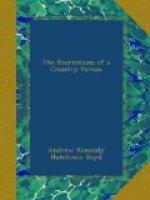Were the efficacy thereof more clearly made out, we scarce conceive the use thereof allowable in physic: exceeding the barbarities of Cambyses, and turning old heroes into unworthy potions. Shall Egypt lend out her ancients unto chirurgeons and apothecaries, and Cheops and Psammeticus be weighed unto us for drugs? Shall we eat of Chamnes and Amasis in electuaries and pills, and be cured by cannibal mixtures? Surely such diet is miserable vampirism; and exceeds in horror the black banquet of Domitian, not to be paralleled except in those Arabian feasts wherein ghouls feed horribly.
I need hardly add that the world has come round to the great physician’s way of thinking, and that mummy is not included in the pharmacopoeia of modern days.
The monumental inscriptions of this country, as a general rule, furnish lamentable proof of the national bad taste. Somehow our peculiar genius seems not to lie in that direction; and very eminent men, who did most other things well, have signally failed when they tried to produce an epitaph. What with stilted extravagance and bombast on the one side, and profane and irreverent jesting on the other, our epitaphs, for the most part, would be better away. It was well said by Addison of the inscriptions in Westminster Abbey,—’Some epitaphs are so extravagant that the dead person would blush; and others so excessively modest that they deliver the character of the person departed in Greek and Hebrew, and by that means are not understood once in a twelve-month.’ And Fuller has hit the characteristics of a fitting epitaph when he said that ’the shortest, plainest, and truest epitaphs are the best.’ In most cases the safe plan is to give no more than the name and age, and some brief text of Scripture.
Every one knows that epitaphs generally are expressed in such complimentary terms as quite explain the question of the child, who wonderingly inquired where they buried the bad people. Mrs. Stone, however, quotes a remarkably out-spoken one, from a monument in Horselydown Church, in Cumberland. It runs as follows:—




